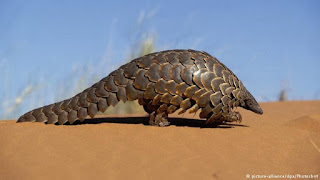Pangolin
Manis javanica belongs to the Mammalian order Pholidota, meaning ‘scaled animals’. The common name ‘pangolin’ is from the Malayan term ‘peng-goling’ (a roller) and refers to the animal’s defence strategy of rolling into a ball (Gotch, 1979).
Malayan pangolins are strikingly unique creatures, whose coat of movable and sharp-tipped scales are reminiscent of descriptions of a dragon's armor or "living pine cones" as they are nicknamed. They are 79-88 cm long, including the tail, and males are typically larger than females. They are covered from just above the nostrils to the tips of their tails by many rows of overlapping scales (17-19 rows on midsection and >20 rows along tail) . The scales on the back and sides are olive-brown to yellowish and hard. These scales are derived from hairs. The underbelly and face are covered in whitish to pale-brown hair, and the skin is gray to bluish.
Males are larger than females. The species has a small conical head with small eyes that are protected by thick eyelids. The external ear parts are greatly reduced. The nose is fleshy, and the mouth lacks teeth. They have extremly long, thin tongues, capable of extending about 25 cm, which covered with a sticky saliva. This helps them collect termites and ants. They have significant adaptations to account for their enormous tongue which passes through the chest cavity and anchors to the pelvis. These include lack of a clavicle, and and odd structure of their xiphisternum (Nowak, 1999). They are pentadactylous; their forefeet are equipt with pads on the soles, large digging claws and are longer and stronger than their hindfeet. Malayan pangolins have prehensile tails and can close their nostril and ear openings.
When pangolins feel threatened, they curl up into a tight, almost impenetrable ball to protect their tender undersides. If caught, they will thrash about using their tail muscles. Because their scales have very sharp edges, they can slice the skin of a human or predator when they do this. They may also release the stinky fluid from their glands as a defense mechanism.
There is not much information known about Malayan pangolin reproduction. But in general, pangolin are just like other mammals, they give birth and breastfeed their children. These pangolin are thought to breed in the autumn, and to give birth in the winter burrow. Gestation is about 130 days. Weaning occurs after three months, and sexual maturity is reached by one year of age.
African pangolin females usually give birth to a single offspring at a time, but the Asiatic species may give birth from one to three. Weight at birth is 80 to 450 g (2.8 to 15.9 oz) and the average length is 150 mm (5.9 in). At the time of birth, the scales are soft and white. After several days, they harden and darken to resemble those of an adult pangolin. During the vulnerable stage, the mother stays with her offspring in the burrow, nursing it, and wraps her body around it if she senses danger. The young cling to the mother's tail as she moves about, although in burrowing species, they remain in the burrow for the first two to four weeks of life. At one month, they first leave the burrow riding on the mother's back. Weaning takes place around three months of age, at which stage the young begin to eat insects in addition to nursing. At two years of age, the offspring are sexually mature and are abandoned by the mother.
Uniqueness :
1. Pangolins have large, curved claws that they use for excavating ant and termite nests, as well as for pulling bark off trees and logs to find their insect prey.
2. Pangolins’ scales are made of keratin, the same protein that makes up our own hair and nails, rhino horns, the “teeth” of baleen whales, and the claws of bears (and other clawed animals). Their scales cover the entire body from head to tip of tail — except for their undersides, which are covered with a few sparse hairs.
3. They do not have teeth and are unable to chew. Instead, they have long sticky tongues that they use to catch the insects they feed on.
4. Some species, such as the Long-tailed pangolin, have prehensile tails that help in climbing in trees and hanging from branches.
Daftar Pustaka :
https://en.m.wikipedia.org/wiki/Pangolin
http://eol.org/pages/337659/details
https://www.pangolins.org/2012/02/18/25-facts-about-pangolins/
https://www.pangolins.org/2012/02/18/25-facts-about-pangolins/
Questions :
1. What is the order of pangolin?
a. chordata
b. pholidota
c. manidae
d. mammalia
e. canidae
2. Pangolin give birth in the .... season.
a. autumnb. winter
c. summer
d. fall
e. spring
3. The gestitation day is about...
a. 110b. 120
c. 130
d. 140
e. 150
4. The color of the scales on the back and sides are...
a. brownb. yellow
c. gray
d. olive-brown
e. black
5. What is the meaning of "the mouth lacks teeth"?
a. don't have teethb. have less teeth
c. have strong teeth
d. have big teeth
e. have a lot of teeth



Komentar
Posting Komentar